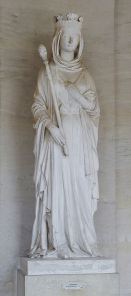 Early medieval women were far from passive damsels waiting for a knight to rescue them.
Early medieval women were far from passive damsels waiting for a knight to rescue them.
Of course, this time period is hardly an ideal time for women: childbirth so risky expectant mothers were urged to confess their sins before they went into labor, fathers choosing whom a girl would marry, age 13 considered marriageable, wife beating defined as a right.
But to say that girls were nothing but pawns valued only for their ability to produce sons grossly oversimplifies medieval women’s reality, and it gives a false impression that women in this era were merely victims who contributed little to their society. Truth is, they tried to shape their situations.
In the mid-eighth century, Saint Boniface depended on both nuns and monks to assist him in his mission to strengthen the church in Europe and spread Christianity. The women left the security of their abbey in Britain and took an uncomfortable, hazardous journey to areas east of the Rhine. Those who were appointed abbesses were not only pious. They were in a position of influence; therefore, they needed to act independently.
On the secular side, aristocratic women did more than produce an heir, although husbands did try to set aside wives unable to bear children. The queen’s role was “to release the king from all domestic and palace cares, leaving him free to turn his mind to the state of his realm,” according to the ninth-century treatise The Government of the Palace. In an age when the personal and political were intertwined, the queen was the guardian of the treasury, and she controlled access to her husband. When houseguests were foreign dignitaries, royal hospitality was key to international relations.
Bertrada, Charlemagne’s mother, had been her husband’s full partner as they seized the kingdom of Francia in a bloodless coup. After he died, she became a diplomat whose most important mission was peace within her own country. Her sons, Charles and Carloman, each inherited half the kingdom, and Bertrada kept the rivalry between the brothers, ages 20 and 17, from escalating to civil war.
Bertrada is just one example. After Carloman died of an illness, and Charles seized his dead brother’s lands, the widow Gerberga was not about to let her toddling sons lose their kingdom without a fight. Likely a teenager, Gerberga crossed the Alps with two little boys in tow and sought the aid of Desiderius, the Lombard king furious over Charles’s divorce from his daughter. Later, Charles’s third wife, Hildegard, might have been the one to convince him to make her sons his heirs, perhaps excluding the son by his first marriage.
These historic women are why the heroines of my novels try to solve their own problems, even when it’s painful. Alda in The Cross and the Dragon has a household to run and servants to keep in line. She bargains with the merchants and gives to charity. Leova in The Ashes of Heaven’s Pillar is a peasant, but at the beginning of the novel, she is a free woman with responsibilities, including children to raise and a house and farm to maintain with her husband. When she is betrayed and sold into slavery, she resents being seen as property and yearns to be a respectable woman again.
The existence of slavery meant that some women were chattel, but so were their male counterparts. But as one can see in this excerpt from The Ashes of Heaven’s Pillar, even slaves could use their wits to get their way.
Looking down, Leova stepped forward, her limbs stiff. Her thoughts were consumed with worry that Deorlaf would rush forward to defend her, just as Derwine would. She glanced over her shoulder.
Sunwynn stood rigid. Deorlaf’s body was tense like a cat ready to pounce into a fight. His hand strayed to his belt where his eating knife used to be. Deorlaf, don’t!
“Peace, Deorlaf,” Ragenard called over Leova’s shoulder. “I mean your mother no harm.”
She felt Ragenard’s hands on her sides and started. The touch against her ribs was gentle. Turning toward Ragenard, she met his gaze. She saw no malice in his amber eyes. A smile flickered on his lips. Then, he straightened and dropped his hands.
“You have cared for her well, my lord,” said Ragenard, his chiseled features impassive. “She is comely and has the temper I seek. So many other serving women are crushed and almost useless or lazy and willful. But this colt is worth more than the best maidservant.” He patted the sleek animal’s shoulder. “He is in his prime, obedient to the rein, yet has enough spirit to charge into the hunt.”
Leova seized the opportunity. “You’re right, Ragenard,” she said, hoping to keep the tremor from her voice. “A horse is worth more than me. Take the children as well.”
“Be still, woman,” Pinabel snarled. “Or I’ll rip out your tongue.”
Sources:
Medieval Women Monastics: Wisdom’s Wellsprings, edited by Miriam Schmitt, Linda Kulzer
Charlemagne: Translated Sources, P.D. King
Carolingian Chronicles: Royal Frankish Annals and Nithard’s Histories, translated by Bernhard Walters Scholz with Barbara Rogers
“Pavia and Rome: The Lombard Monarchy and the Papacy in the Eighth Century,” Jan T. Hallenbeck, published in 1982 by Transactions of the American Philosophical Society
“Women at the Court of Charlemagne: A Case of Monstrous Regiment?” Janet L. Nelson,The Frankish World 750-900
“Family Structures and Gendered Power in Early Medieval Kingdoms: The Case for Charlemagne’s Mother,” Janet L. Nelson. Women Rulers in Europe: Agency, Practice and Representation of Political Powers (XII-XVIII)
Daily Life in the World of Charlemagne, Pierre Riche
Reprinted from Reginajeffers.wordpress.com.
Kim Rendfeld has had a lifelong fascination with fairy tales and legends, which set her on her quest to write The Cross and the Dragon. She grew up in New Jersey and attended Indiana University, where she earned a bachelor’s degree in journalism and English, with a minor in French. If it weren’t for feminism, she would be one of those junior high English teachers scaring the bejesus out of her students and correcting grammar to the point of obnoxiousness. Instead, her career has been in journalism, public relations, and now fiction.
Kim was a journalist for almost twenty years at Indiana newspapers, including the Journal and Courier in Lafayette, The Muncie Star, and The News and Sun in Dunkirk, and she won several awards from the Hoosier State Press Association. Her career changed in 2007, when she joined the marketing and communications team at Ball State University in Muncie, Indiana. She gets paid to agonize over commas and hyphens, along with suggesting ways to improve writing, and thoroughly enjoys it. She is proud to have been part of projects that have received national recognition. Kim lives in Indiana with her husband, Randy, and their spoiled cats. They have a daughter and three granddaughters.
To read the first chapters of either novel [The Cross and the Dragon (2012, Fireship Press) or The Ashes of Heaven’s Pillar (2014 Fireship Press)] or learn more about Kim, visit kimrendfeld.com.
You’re also welcome to visit her blog Outtakes of a Historical Novelist, at kimrendfeld.wordpress.com, like her on Facebook at facebook.com/authorkimrendfeld, or follow her on Twitter at @kimrendfeld, or contact her at kim @ kimrendfeld.com.



